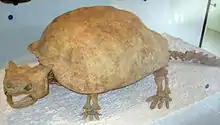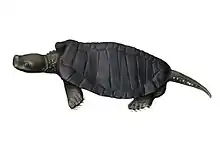Meiolaniidae
Meiolaniidae is an extinct family of large, possibly herbivorous stem-turtles with heavily armored heads and tails known from South America and most of Oceania. Though once believed to be cryptodires, they are not closely related to any living species of turtle, and lie outside crown group Testudines, having diverged from them around the Middle Jurassic.[2][3][4] They are best known from the last surviving genus, Meiolania, which lived in the rain forests of Australia from the Miocene until the Pleistocene, and insular species that lived on Lord Howe Island and New Caledonia during the Pleistocene and possibly the Holocene for the latter.
| Meiolaniidae | |
|---|---|
 | |
| Meiolania platyceps | |
 | |
| Niolamia skull | |
| Scientific classification | |
| Kingdom: | Animalia |
| Phylum: | Chordata |
| Class: | Reptilia |
| Clade: | †Meiolaniformes |
| Family: | †Meiolaniidae Lydekker, 1887 |
| Genera | |
| |
A similar form is also known from the Miocene Saint Bathans fauna of New Zealand.[5]
The family was once thought to have originated in Australia sometime in the Miocene, when the earliest Meiolania first appeared. However, due to the discovery of South American meiolaniids, including Niolamia in Eocene Argentina, it is now believed that the meiolaniids appeared sometime prior to the breakup of South America, Australia and Antarctica during the Eocene.
More recently, Eocene Australian species have also been uncovered.[6]
References
- Sterli, Juliana; de la Fuente, Marcelo S.; Krause, J. Marcelo (2015). "A new turtle from the Palaeogene of Patagonia (Argentina) sheds new light on the diversity and evolution of the bizarre clade of horned turtles (Meiolaniidae, Testudinata)". Zoological Journal of the Linnean Society. 174 (3): 519–548. doi:10.1111/zoj.12252.
- Anquetin, Jérémy (2012). "Reassessment of the phylogenetic interrelationships of basal turtles (Testudinata)". Journal of Systematic Palaeontology. 10: 3–45. doi:10.1080/14772019.2011.558928.
- Sterli, Juliana (2010). "Phylogenetic relationships among extinct and extant turtles: The position of Pleurodira and the effects of the fossils on rooting crown-group turtles". Contributions to Zoology. 79 (3): 93–106. doi:10.1163/18759866-07903002. hdl:11336/84233.
- Sterli, Juliana; de la Fuente, Marcelo S. (2013). "New evidence from the Palaeocene of Patagonia (Argentina) on the evolution and palaeo-biogeography of Meiolaniformes (Testudinata, new taxon name)". Journal of Systematic Palaeontology. 11 (7): 835–852. doi:10.1080/14772019.2012.708674.
- Worthy, Trevor H.; Tennyson, Alan J. D.; Hand, Suzanne J.; Godthelp, Henk; Scofield, R. Paul (2011). "Terrestrial Turtle Fossils from New Zealand Refloat Moa's Ark". Copeia. 2011: 72–76. doi:10.1643/CH-10-113.
- Poropat, Stephen F.; Kool, Lesley; Vickers-Rich, Patricia; Rich, Thomas H. (2017). "Oldest meiolaniid turtle remains from Australia: Evidence from the Eocene Kerosene Creek Member of the Rundle Formation, Queensland". Alcheringa: An Australasian Journal of Palaeontology. 41 (2): 231–239. doi:10.1080/03115518.2016.1224441.


